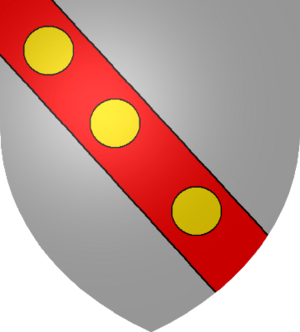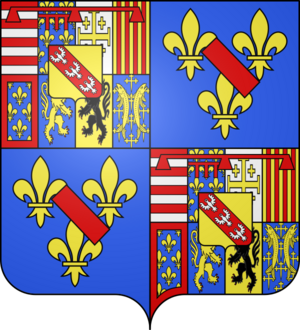Counts and dukes of Aumale facts for kids
The County of Aumale was a historical territory in Normandy, a region in France. It was like a small kingdom, called a fief, ruled by a count. Later, it became a larger territory known as a duchy, ruled by a duke. Aumale was often fought over by England and France, especially during the Hundred Years' War.
Contents
Aumale's Early History
Aumale was an important territory in the Duchy of Normandy. After 1066, when William the Conqueror became King of England, Aumale also became connected to the English Crown.
The land of Aumale was given to Adelaide of Normandy, who was William the Conqueror's half-sister. She received it as a dower (property given to a wife) from her first husband. When he died, Aumale passed to her next husbands because they married her. This was known as jure uxoris, meaning "by right of his wife."
In 1086, records show Adelaide as the Countess of Aumale. Her son, Stephen of Aumale, later inherited the territory.
Counts of Aumale (Anglo-Norman Line)
Here are some of the early counts of Aumale who were connected to both England and Normandy:
- Odo of Troyes (1069–1115) – He was married to Adelaide.
- Stephen of Aumale (before 1070–1127) – Son of Odo and Adelaide.
- William le Gros (1127–1179)
- Hawise of Aumale (1179–1194) – She held the title with her husbands:
- William de Mandeville, 3rd Earl of Essex (1180–1189)
- William de Forz (1189–1194)
- Baldwin of Bethune (1195–1196)
In 1196, the French king took control of Aumale. However, the English kings still claimed the title, calling it the Earl of Albemarle.
Aumale in French Nobility
In 1196, Philip II of France captured the castle of Aumale. He then gave the title of "Count of Aumale" to Renaud de Dammartin. Over time, different powerful families in France held this title, including the houses of Castile, Harcourt, and Lorraine.
The title was later re-established as a "Duchy" in 1547 for Francis, Duke of Guise. He then gave it to his brother, Claude, Duke of Aumale. The title was also used by Henri d'Orléans, Duke of Aumale, who was the youngest son of Louis Philippe I, a King of the French.
As of 2019, a grandson of Henri, Count of Paris, holds the title of Duke of Aumale.
Counts of Aumale (French Line)
Here are some of the French counts of Aumale:
- Renaud I, Count of Dammartin (1224–1227)
- Mathilde de Dammartin (1227–1260) – She was also a Queen of Portugal.
- Ferdinand I (1239–1252) – Part of the House of Castile.
- John I (1260–1302)
- John II (1302–1343)
- Blanche of Ponthieu (1343–1387)
- John III (1343–1356) – Part of the House of Harcourt.
- John V (1389–1452)
- Mary (1424–1476)
- Antoine, Count of Vaudémont (1452–1458) – Part of the House of Lorraine-Vaudémont.
- René (1473–1508)
- Claude I (1508–1547)
Dukes of Aumale (French Line)
- Francis (1547–1550)
- Claude II (1550–1573)
- Charles (1573–1595)
- Anne (1618–1638)
- Henry of Savoy (1618–1632) – Married to Anne.
- Louis of Savoy (1638–1641)
- Charles Amadeus of Savoy (1641–1652)
- Louis Charles de Bourbon (1701–1773)
- Louis Jean Marie of Bourbon (1776–1793)
- Henri d'Orléans, Duke of Aumale (1822–1897)
Aumale in English Nobility
During the Hundred Years' War, English kings sometimes ruled Aumale. This was because they claimed to be the rightful Dukes of Normandy and, later, Kings of France. The title of Count or Duke of Aumale was given out several times by English monarchs.
Even after France captured Aumale in 1196, English kings still recognized the title. They often called it the Earl of Albemarle.
Earls of Aumale (English Line)
- Hawise of Aumale (died 1214) – She was the 2nd Countess of Aumale. Her husband, Baldwin of Bethune, was also called Count of Aumale.
- William de Forz, 3rd Earl of Albemarle (died 1242) – Hawise's son.
- William de Forz, 4th Earl of Albemarle (died 1260) – Son of the 3rd Earl.
- Aveline de Forz, Countess of Albemarle (died 1274) – Daughter of the 4th Earl. She married Edmund Crouchback, 1st Earl of Lancaster, but had no children. After her death, the title went back to the English Crown.
Dukes of Aumale (English Creations)
- Thomas of Woodstock, 1st Duke of Gloucester (died 1397) – He was the fifth son of Edward III of England. He was made Duke of Aumale in 1385, but he was also made Duke of Gloucester soon after. He probably never used the Aumale title.
- Edward of Norwich (died 1415) – He was made Duke of Aumale in 1397. However, Henry IV of England took the title away from him in 1399.
- Thomas of Lancaster, 1st Duke of Clarence (1387–1421) – He was the second son of Henry IV of England. He was made Earl of Aumale in 1412, along with his title of Duke of Clarence. He held both titles until he died without children.
- Richard de Beauchamp, 13th Earl of Warwick (1382–1439) – He was a military leader for Henry V of England. He was made Count of Aumale for his lifetime only.
After the Hundred Years' War, the English title of Aumale was spelled as Albemarle. You can find more about these titles under Duke of Albemarle and Earl of Albemarle.





